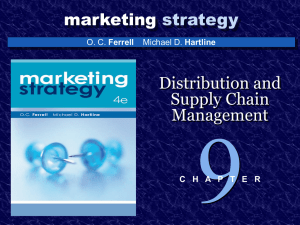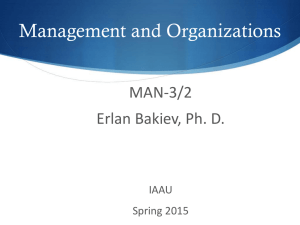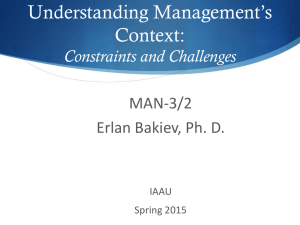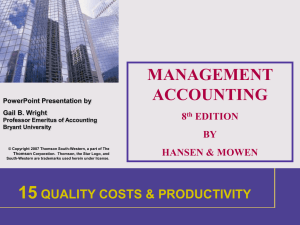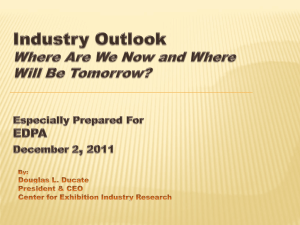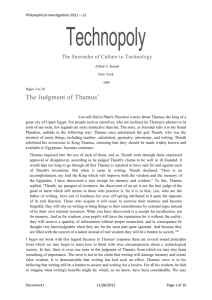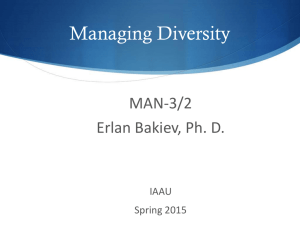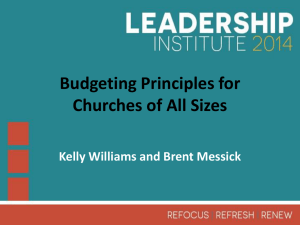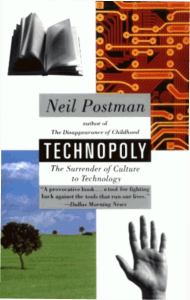ENVIRONMENTAL COSTING
advertisement
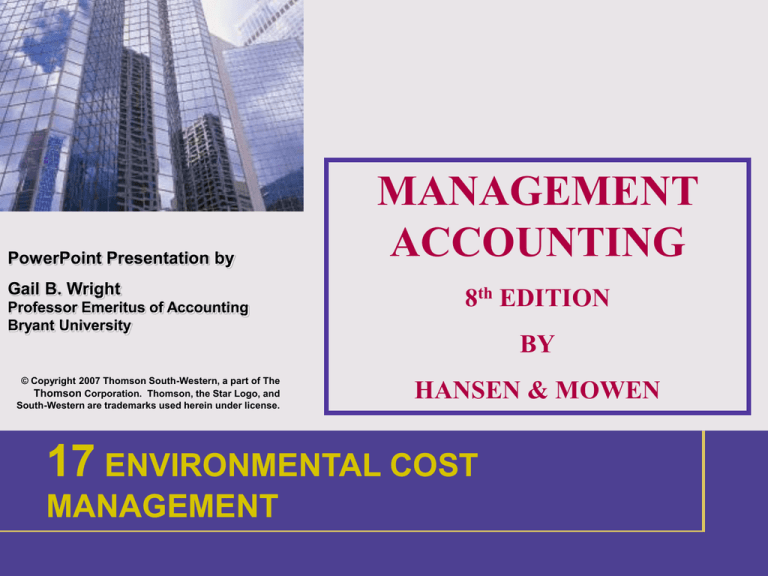
PowerPoint Presentation by Gail B. Wright Professor Emeritus of Accounting Bryant University MANAGEMENT ACCOUNTING 8th EDITION BY © Copyright 2007 Thomson South-Western, a part of The Thomson Corporation. Thomson, the Star Logo, and South-Western are trademarks used herein under license. HANSEN & MOWEN 17 ENVIRONMENTAL COST 1MANAGEMENT INTRODUCTION 1 LEARNING OBJECTIVES LEARNING GOALS After studying this chapter, you should be able to: 2 LEARNING OBJECTIVES 1. Discuss the importance of measuring environmental costs. 2. Explain how environmental costs are assigned to products & processes. 3. Describe the life-cycle cost assessment model. 4. Compare & contrast activity- & strategicbased environmental control. Click the button to skip Questions to Think About 3 QUESTIONS TO THINK ABOUT: Thamus, Inc. What are environmental costs? Are environmental costs significant enough to track & report to management? 4 QUESTIONS TO THINK ABOUT: Thamus, Inc. Will improving environmental performance increase or decrease total environmental costs? 5 QUESTIONS TO THINK ABOUT: Thamus, Inc. Should environmental costs be assigned to products & processes as a separate item? 6 QUESTIONS TO THINK ABOUT: Thamus, Inc. What is the best way to control environmental costs? 7 QUESTIONS TO THINK ABOUT: Thamus, Inc. Should companies be concerned about environmental costs that they cause but for which they do not have financial responsibility? 8 LEARNING OBJECTIVE 1 Discuss the importance of measuring environmental costs. 9 LO 1 Why is it important to measure environmental costs? Awareness of environmental costs is important because environmental regulations & fines have increased. 10 LO 1 ECOEFFICIENCY: Definition Maintains that producing more useful goods, services is consistent with reducing negative environmental impacts. 11 LO 1 SUSTAINABLE DEVELOPMENT: Definition Is development that meets needs of present without compromising ability of future generations to meet their own needs. 12 LO 1 ECOEFFICIENCY Many things provide causes & incentives that foster ecoefficiency. EXHIBIT 17-1 13 LO 1 ENVIRONMENTAL QUALITY COST MODEL Looks at costs and their impact for damage done to the environment. In addition to direct costs, there are costs to preventing environmental degradation. 14 LO 1 ENVIRONMENTAL DETECTION COSTS Are costs to determine compliance with appropriate environmental standards including: Regulatory government laws Voluntary standards (ISO 14001) Management’s environmental policies 15 LO 1 What are environmental external failure costs? Environmental external failure costs are costs of activities performed after discharging contaminants & waste into the environment. 16 LO 1 What information does an environmental cost report provide? Environmental cost reports reveal 1) the impact of environmental costs on firm profitability & 2) relative amounts expended in each category. 17 LO 1 ENVIRONMENTAL COST REPORT External failure costs are the largest costs. EXHIBIT 17-3 18 LO 1 Can environmental failure costs be reduced? Yes! Investing more in prevention & detection activities will reduce environmental failure costs. 19 LO 1 ENVIRONMENTAL FINANCIAL STATEMENT Investments in environmental benefits partially offset environmental costs. EXHIBIT 17-4 20 LEARNING OBJECTIVE 2 Explain how environmental costs are assigned to products & processes. 21 LO 1 ASSIGNING ENVIRONMENTAL COSTS Product costs Packaging Products themselves Process costs Solid, liquid, gaseous residues 22 LO 2 ENVIRONMENTAL COSTING: Definition Full environmental costing assigns both private & societal costs to products. Private costs are caused by internal processes. 23 LO 2 THAMUS, INC.: Background Two approaches can be used to assign environmental costs to products: functional-based or activity-based costing. Environmental costs, often hidden in overhead are separated out to assign to products. Functional-based costing may work well for homogeneous products, but Thamus is a diversified, multi-product firm. 24 LO 2 FORMULA: Cadmium Example Costs are assigned proportionately when multiple products are produced. External failure cost: = Total failure cost ÷ Units produced = $150,000 / 20,000 = $7.50 per unit 25 LEARNING OBJECTIVE 3 Describe the life-cycle cost assessment model. 26 LO 3 LIFE-CYCLE ASSESSMENT: Definition Identifies environmental consequences of a product through its entire life cycle & searches for improvements. 27 LO 3 PRODUCT LIFE-CYCLE STAGES Some costs are controlled by the supplier while others are controlled by customers. EXHIBIT 17-6 28 LO 3 ASSESSMENT STAGES 3 formal stages Inventory analysis Types, quantities inputs needed Environmental releases Impact analysis Effects of competing designs Relative ranking of effects Improvement analysis Objective: to reduce environmental impacts 29 LEARNING OBJECTIVE 4 Compare & contrast activity- & strategicbased environmental control. 30 LO 4 ENVIRONMENTAL PERSPECTIVE 5 objectives for environmental perspective Minimize use of raw or virgin materials Minimize use of hazardous materials Minimize energy requirements for production, use of product Minimize release of solid, liquid, gaseous residues Maximize opportunities to recycle 31 LO 4 OBJECTIVES & PERSPECTIVES Companies need measures to evaluate whether objectives of the environmental perspective are being met. EXHIBIT 17-8 32 LO 4 Are environmental activities non-value-added? Because environmental pollution is equivalent to economic inefficiency, all failure activities are non-value-added. 33 LO 4 What are some good ways to examine effects of environmental activities? Graphical presentations are effective in depicting positive benefits of environmental. 34 LO 4 ENVIRONMENTAL COST TREND GRAPH Costs as a percentage of sales trend downward over time. % EXHIBIT 17-10 35 LO 4 BAR GRAPH FOR TRENDS Emissions trend downward over time. % EXHIBIT 17-11 36 LO 4 HAZARDOUS WASTE PIE CHART Pie chart depicts proportional hazardous wastes. EXHIBIT 17-12 37 CHAPTER 17 THE END 38

